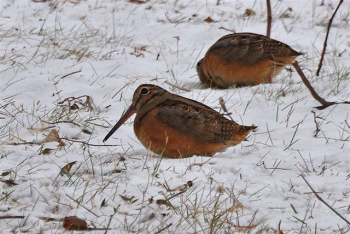Snow and the Early Birds
As we write this, a major March snowstorm is beginning that is forecast to drop as much as a foot and half of snow over the course of the day. Many readers will also be aware that many of our earlier-arriving birds have already appeared here in Maine, leaving us to wonder about their fate and how they may cope with the storm.
One of birds that many people think of as a harbinger of spring is the red-winged blackbird. It brings joy to the heart to hear the “onk-a-lee” of an eager male singing from the top of a tree beside a still-frozen solid lake and marsh. Red-winged blackbirds, brown-headed cowbirds, rusty blackbirds, and common grackles are among the earliest arrivals back in the spring. This is, in part, because they winter pretty far north, a few even sometimes persisting through the Maine winter, usually in coastal locations but certainly as far north as southern New England and the mid-Atlantic states. That means they don’t have too far to travel to get here in the spring. It also means, thankfully for them, that they are hardy birds that are used to dealing with intermittent snow storms and cold weather. All the blackbirds seem to be very clever at tracking down active bird feeding stations, perhaps by paying attention to and following where local, resident birds are feeding.
Birds like red-winged blackbirds and other blackbirds are also good at finding places to roost at night (or when the snow gets really heavy) like thick conifers that shield them from the snow and conserve their body heat.
Various duck species have also returned for the spring including wood duck, ring-necked duck, green-winged teal, and others. These, too, are birds that winter regularly into the mid-Atlantic states. A March snowstorm will probably have minimal impact except to make them a bit uncomfortable as the snow piles up on their backs! As long as the water stays open and there are still open shallow areas where they can find food, we predict that they’ll be minimally affected.
Luckily tree swallows have not yet been reported back, as they could have a more difficult time. The most difficult conditions for tree swallows are when they are faced with extended periods of very cold weather. Because they are almost exclusively aerial insect eaters (they have been known to eat some berries under extreme conditions) and because insects are not active when it is really cold, they can only survive for so long before starvation hits and they perish. A snow storm might not be as severe a problem for them as long as the temperatures after the storm don’t remain low.
One species that we can’t help but worry about in the snow storm is the American woodcock. A short-legged, plump ground-dwelling shorebird with a long bill, the American woodcock is most famous as the bird that engages in its courtship at dusk when its buzzy “beep” call can be heard from field edges. Woodcock have returned in many parts of Maine, and they make their living by probing the ground for worms and other creatures. These birds spend all their time on the ground, walking around looking for food, sleeping on the ground, and fly only to get from one patch of ground to another or when startled. When snow covers the ground, they have to get creative to find little open patches, perhaps under a tree, along the edge of a lake or stream, or even in the narrow area along the foundation of a house.
Nature will take its course, and the good news is that birds are amazingly resilient. So keep those feeders stocked and hope for the best!
Jeffrey V. Wells, Ph.D., is a Fellow of the Cornell Lab of Ornithology. Dr. Wells is one of the nation's leading bird experts and conservation biologists, and author of “Birder’s Conservation Handbook.” His grandfather, the late John Chase, was a columnist for the Boothbay Register for many years. Allison Childs Wells, formerly of the Cornell Lab of Ornithology, is a senior director at the Natural Resources Council of Maine, a statewide nonprofit membership organization working to protect the nature of Maine. Both are widely published natural history writers and coauthors of the book, “Maine’s Favorite Birds.”































